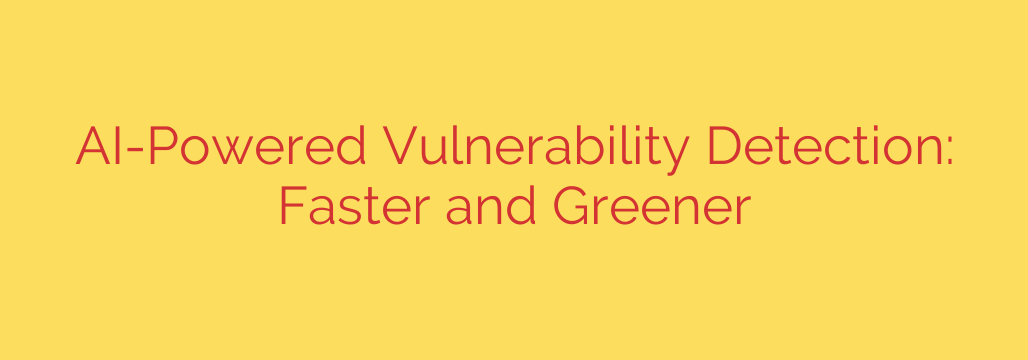
The AI Revolution in Cybersecurity: Faster, Smarter, and More Sustainable
In today’s fast-paced digital world, the race between software developers and malicious actors is more intense than ever. For every new application launched, there are countless threats looking to exploit hidden weaknesses. The traditional methods of finding these security flaws, while valuable, are struggling to keep up. They are often slow, resource-intensive, and can overwhelm security teams with false alarms.
Fortunately, a powerful new ally has emerged: Artificial Intelligence. AI is not just changing the game; it’s rewriting the rules for how we approach vulnerability detection. By leveraging machine learning and deep learning, organizations can now identify threats with unprecedented speed, accuracy, and even environmental efficiency.
The Limitations of Traditional Security Scans
For years, security has relied on tools like Static Application Security Testing (SAST) and Dynamic Application Security Testing (DAST). SAST tools scan source code for known vulnerability patterns, while DAST tools test a running application from the outside in.
While essential, these methods have significant drawbacks:
- Slow Turnaround: A comprehensive scan can take hours or even days, creating a major bottleneck in modern, agile development cycles.
- High False Positives: Traditional scanners often lack context, flagging issues that aren’t real threats. This forces developers to waste valuable time sifting through noise instead of fixing genuine vulnerabilities.
- Resource Heavy: These scans demand significant computational power, driving up operational costs and energy consumption in data centers.
How AI is Creating a Paradigm Shift
AI-powered vulnerability detection operates on a completely different level. Instead of relying on rigid, predefined rules, machine learning models are trained on vast datasets of both vulnerable and secure code. This allows them to understand context, recognize complex patterns, and even predict novel types of attacks.
Here are the key advantages of bringing AI into your security workflow:
1. Unmatched Speed and Scalability
AI can analyze millions of lines of code in a fraction of the time it would take traditional scanners or a human expert. This incredible speed means security checks can be seamlessly integrated into every stage of the development pipeline (a concept known as DevSecOps) without slowing developers down. AI-driven tools provide near-instant feedback, allowing developers to fix vulnerabilities as they write them.
2. Superior Accuracy and Reduced Noise
One of the most significant benefits of AI is its ability to understand the context of the code. It can differentiate between a genuine threat and a benign coding anomaly, drastically reducing the number of false positives. This means your security and development teams can focus their efforts on fixing real, high-impact vulnerabilities that matter. By learning from past findings, the AI model continuously improves its accuracy over time.
3. Proactive and Predictive Threat Hunting
Cybercriminals are constantly devising new attack methods. AI-powered systems excel at identifying these “zero-day” vulnerabilities. By recognizing the subtle characteristics of malicious code patterns, AI can flag suspicious code that might not match any known signature but exhibits traits of a potential exploit. This shifts security from a reactive posture to a proactive one.
The Surprising Green Benefit: Sustainable Security
Beyond being faster and smarter, AI-driven security offers a compelling environmental advantage. Efficiency in computing directly translates to energy savings.
Traditional, lengthy security scans require servers to run at high capacity for extended periods, consuming significant amounts of electricity and contributing to a larger carbon footprint. In contrast, the efficiency of AI-powered analysis drastically reduces computation time and energy consumption. By completing scans faster, you minimize the load on your infrastructure, leading to lower energy bills and a more sustainable IT operation. This makes AI-powered security not only a smart business decision but also a responsible one.
Actionable Steps for Integrating AI into Your Security
Adopting AI-powered security doesn’t have to be an overwhelming overhaul. Here are a few practical tips to get started:
- Augment, Don’t Replace: View AI tools as a powerful assistant for your security experts. Use AI to handle the heavy lifting of initial scans, freeing up your human talent to focus on complex threat validation, strategic planning, and remediation.
- Integrate into the CI/CD Pipeline: The true power of AI is realized when it’s embedded directly into the developer workflow. Integrating AI scanning tools into your Continuous Integration/Continuous Deployment (CI/CD) pipeline ensures that security is an automated, continuous part of the process, not an afterthought.
- Prioritize Contextual Alerts: Choose an AI solution that provides clear, contextual explanations for the vulnerabilities it finds. The best tools not only flag an issue but also explain why it’s a threat and offer specific guidance for remediation.
The future of application security is intelligent, automated, and proactive. By embracing AI, organizations can build more resilient software, empower their developers to innovate securely, and contribute to a more sustainable technological ecosystem. It’s time to move beyond the limitations of the past and harness the power of AI to build a safer digital future.
Source: https://www.helpnetsecurity.com/2025/07/31/white-basilisk-ai-vulnerability-detection/








